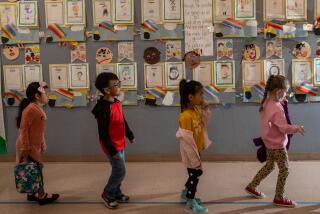What to Watch, Listen for in Children
- Share via
As with almost everything, children vary in their development of speech and language. There are, however, identifiable “milestones” that can help determine if a child falls within the “normal” range. Here are some milestones by age:
Birth to 6 months: Reacts to loud sounds. Turns head toward a sound source. Laughs, cries and fusses. Makes noise when talked to.
6 months to 1 year: Repeats repetitive syllables or babbles, such as “da, da, da.” Tries to communicate by actions or gestures. Attempts to repeat your sounds.
1 year to 18 months: Follows simple directions accompanied by gestures. Answers simple questions nonverbally. Can recognize and point to common objects. Tries to imitate simple words.
18 to 24 months: Follows simple directions without gestures. Says eight to 10 words. Understands simple verbs such as “eat” and “sleep.” Correctly pronounces most vowels and n, m, p and h (particularly at the beginning of syllables and short words).
2 to 3 years: Says about 40 words at 24 months. Answers simple questions. Speaks in two-to three-word phrases. Speech becomes more accurate but may still leave off ending sounds. (Strangers may not be able to understand much of what is said.)
3 to 4 years: Uses most speech sounds but may distort some of the more difficult sounds such as l, r, s, sh, ch, y, v, z and th. (These sounds may not be fully mastered until age 7 or 8.) Strangers are able to understand most of what is said. Expresses ideas and feelings verbally.
4 to 5 years: Understands complex questions. Speech is understandable but makes mistakes pronouncing long, difficult or complex words, such as “hippopotamus.” Says about 200 to 300 words.
5 years: Understands more than 2,000 words. Engages in conversation. Uses sentences of eight or more words in length.
*
Source: National Institute on Deafness and Other Communication Disorders. More information is available at https://www.nidcd.nih.gov/health/parents/speechandlanguage.htm.
